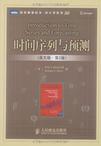时间序列与预测
2009-3-1
人民邮电出版社
Peter J.Brockwell,Richard A.Da
437
无
This book is aimed at the reader who wishes to gain a working knowledge of timeseries and forecasting methods as applied in economics, engineering and the naturaland social sciences. Unlike our earlier book, Time Series: Theory and Methods, re-ferred to in the text as TSTM, this one requires only a knowledge of basic calculus,matrix algebra and elementary statistics at the level (for example) of Mendenhall,Wackerly and Scheaffer (1990). It is intended for upper-level undergraduate studentsand beginning graduate students.The emphasis is on methods and the analysis of data sets. The student versionof the time series package ITSM2000, enabling the reader to reproduce most of thecalculations in the text (and to analyze further data sets of the reader's own choosing),is included on the CD-ROM~~which accompanies the book. The data sets used in thebook are also included. The package requires an IBM-compatible PC operating underWindows 95, NT version 4.0, or a later version of either of these operating systems.The program ITSM can be run directly from the CD-ROM or installed on a hard diskas described at the beginning of Appendix D, where a detailed introduction to thepackage is provided.Very little prior familiarity with computing is required in order to use the computerpackage. Detailed instructions for its use are found in the on-line help files whichare accessed, when the program ITSM is running, by selecting the menu optionHelp>Contents and selecting the topic of interest. Under the heading Data youwill find information concerning the data sets stored on the CD-ROM. The book canalso be used in conjunction with other computer packages for handling time series.Chapter 14 of the book by Venables and Ripley (1994) describes how to performmany of the calculations using S-plus.There are numerous problems at the end of each chapter, many of which involveuse of the programs to study the data sets provided.To make the underlying theory accessible to a wider audience, we have statedsome of the key mathematical results without proof, but have attempted to ensurethat the logical structure of the development is otherwise complete. (References toproofs are provided for the interested reader.)
《时间序列与预测(英文版)(第2版)》是时间序列领域的名著。特色在于注重实际应用。深浅适中,适用面广,示例和习题丰富,有微积分、线性代数和统计学基础知识即可阅读。书中全面介绍了经济、工程、自然科学和社会科学中所用的时间序列和预测方法,核心内容是平稳过程、ARMA模型和ARIMA模型、多元时间序列和状态空间模型、谱分析。书中配有时间序列软件包ITSM2000学生版,更加方便读者学习。
作者:(美国)Peter J.Brockwell (美国)Richard A.DavisPeter J.Brockwell 世界著名统计学家。ASA(美国统计协会)、IMS(数理统计学会)会士。科罗拉多州立大学统计系荣休教授。他是Journalof Time Series Analysis副主编,并Li Richard A.Davis合作开发了时间序列软件包ITSM2000。Richard A.Davis 世界著名统计学家。ASA(美国统计协会)、IMS(数理统计学会)会士。科罗拉多州立大学统计系教授,1997年至2005年担任该系的系主任。1 998年荣获计量经济学Koopmans奖。他是Stochastic Processes and Their Applications,Annals of Applied Probability等期刊编委,是Proceedings ofthe American Mathematics Society的统计学领域主编。
1. Introduction1.1. Examples of Time Series1.2. Objectives of Time Series Analysis1.3. Some Simple Time Series Models1.3.1. Some Zero-Mean Models1.3.2. Models with Trend and Seasonality1.3.3. A General Approach to Time Series Modeling1.4. Stationary Models and the Autocorrelation Function1.4.1. The Sample Autocorrelation Function1.4.2. A Model for the Lake Huron Data1.5. Estimation and Elimination of Trend and Seasonal Components1.5.1. Estimation and Elimination of Trend in the Absence ofSeasonality1.5.2. Estimation and Elimination of Both Trend andSeasonality1.6. Testing the Estimated Noise SequenceProblems2. Stationary Processes2.1. Basic Properties2.2. Linear Processes2.3. Introduction to ARMA Processes2.4. Properties of the Sample Mean and Autocorrelation Function2.4.1. Estimation of tz2.4.2. Estimation of y(.) and p(.)2.5. Forecasting Stationary Time Series2.5.1. The Durbin-Levinson Algorithm2.5.2. The Innovations Algorithm2.5.3. Prediction of a Stationary Process in Terms of InfinitelyMany Past Values2.6. The Wold DecompositionProblems3. ARMA Models3.1. ARMA(p, q) Processes3.2. The ACF and PACF of an ARMA(p, q) Process3.2.1. Calculation of the ACVF3.2.2. The Autocorrelation Function3.2.3. The Partial Autocorrelation Function3.2.4. Examples3.3. Forecasting ARMA ProcessesProblems4. Spectral Analysis4.1. Spectral Densities4.2. The Periodogram4.3. Time-Invariant Linear Filters4.4. The Spectral Density of an ARMA ProcessProblems5. Modeling and Forecasting with ARMA Processes5. I. Preliminary Estimation5.1.1. Yule-Walker Estimation5.1.2. Burg's Algorithm5.1.3. The Innovations Algorithm5.1.4. The Hannan-Rissanen Algorithm5.2. Maximum Likelihood Estimation5.3. Diagnostic Checking5.3.1. The Graph of5.3.2. The Sample ACF of the Residuals5.3.3. Tests for Randomness of the Residuals5.4. Forecasting5.5. Order Selection5.5.1. The FPE Criterion5.5.2. The AICC CriterionProblems6. Nonstationary and Seasonal Time Series Models6.1. ARIMA Models for Nonstationary Time Series6.2. Identification Techniques6.3. Unit Roots in Time Series Models6.3.1. Unit Roots in Autoregressions6.3.2. Unit Roots in Moving Averages6.4. Forecasting ARIMA Models6.4.1. The Forecast Function6.5. Seasonal ARIMA Models6.5.1. Forecasting SARIMA Processes6.6. Regression with ARMA Errors6.6.1. OLS and GLS Estimation6.6.2. ML EstimationProblems7. Multivariate Time Series7.1. Examples7.2. Second-Order Properties of Multivariate Time Series7.3. Estimation of the Mean and Covariance Function7.3.1. Estimation of7.3.2. Estimation of F(h)7.3.3. Testing for Independence of Two Stationary Time Series7.3.4. Bartlett's Formula7.4. Multivariate ARMA Processes7.4.1. The Covariance Matrix Function of a Causal ARMAProcess7.5. Best Linear Predictors of Second-Order Random Vectors7.6. Modeling and Forecasting with Multivariate AR Processes7.6.1. Estimation for Autoregressive Processes Using Whittle'sAlgorithm7.6.2. Forecasting Multivariate Autoregressive Processes7.7. CointegrationProblems8. State-Space Models8.1. State-Space Representations8.2. The Basic Structural Model8.3. State-Space Representation of ARIMA Models8.4. The Kalman Recursions8.5. Estimation For State-Space Models8.6. State-Space Models with Missing Observations8.7. The EM Algorithm8.8. Generalized State-Space Models8.8.1. Parameter-Driven Models8.8.2. Observation-Driven ModelsProblems9. Forecasting Techniques9.1. The ARAR Algorithm9.1.1. Memory Shortening9.1.2. Fitting a Subset Autoregression9.1.3. Forecasting9.1.4. Application of the ARAR Algorithm9.2. The Holt-Winters Algorithm9.2.1. The Algorithm9.2.2. Holt-Winters and ARIMA Forecasting9.3. The Holt-Winters Seasonal Algorithm9.3.1. The Algorithm9.3.2. Holt-Winters Seasonal and ARIMA Forecasting9.4. Choosing a Forecasting AlgorithmProblems10. Further Topics10.1. Transfer Function Models10.1.1. Prediction Based on a Transfer Function Model10.2. Intervention Analysis10.3. Nonlinear Models10.3.1. Deviations from Linearity10.3.2. Chaotic Deterministic Sequences10.3.3. Distinguishing Between White Noise and iid Sequences10.3.4. Three Useful Classes of Nonlinear Models10.3.5. Modeling Volatility10.4. Continuous-Time Models10.5. Long-Memory ModelsProblemsA. Random Variables and Probability DistributionsA. 1. Distribution Functions and ExpectationA.2. Random VectorsA.3. The Multivariate Normal DistributionProblemsB Statistical ComplementsC Mean Square ConvergenceD An ITSM TutorialReferencesIndex
插图:
“这本书就像一书很好的科幻小说,让你爱不释手。……趣味无穷的例于,丰富得让你难以置信。……无论是自学,还是课堂教学、本书都是一本理想的教材。强烈推荐!”——SIAM书评“本书强调实际经验,配套软件也起纠厂很好的作用。……祝贺作者,他们让这门课程变得容易而有趣。阅读本书是一种享受,极力推荐。这是本领域最好的入门教材。”——国际统计学会(ISI)书评
《时间序列与预测(英文版第2版)》全面介绍了经济学、工程学、自然科学和社会科学中所用的时间序列和预测方法,核心内容是平稳过程、ARMA过程、ARIMA过程、多变量时间序列、状态空间模型和谱分析。另外,《时间序列与预测(英文版第2版)》还介绍了Burg算法、Hannan—Riissanen算法、EM算法、结构模型、指数平滑、转移函数模型、非线性模型、连续时间模型和长记忆模型等,每章的末尾都有大量习题,供读者巩固所学概念和方法,《时间序列与预测(英文版第2版)》强调方法和数据集的分析,配有时间序列软件包ITSM2000的学生版。《时间序列与预测(英文版第2版)》适合作为各专业学生时间序列入门课程的教材,也适合其他有兴趣的科研工作者阅读。

无
书的确是挺好的,但是明明这本书是有附带的CD的,可拿到手里并没有呀。如果它能加入详细的条件异方差模型的研究就更好了。
最好把书的封面贴上
许多内容感觉是不一般的严谨 但是同时增加了难度
内容很详细,不过不适合初学者。
纸张质量很好,有深度,没时间读完,哎
RT,买了一阵了,刚拆开看,没有光盘啊!!
拿到书,看看前页说有光盘,翻了半天,影子都没有看到,没这么打折的吧。
还好这本没被糟蹋成中文,上一本真是可惜了!
首先声明,我对此书的评论与AMAZON的服务无关。这本书内容不错,和其他TIME... 阅读更多
随书光盘呢?????
很好的时序书,特别适合反复阅读